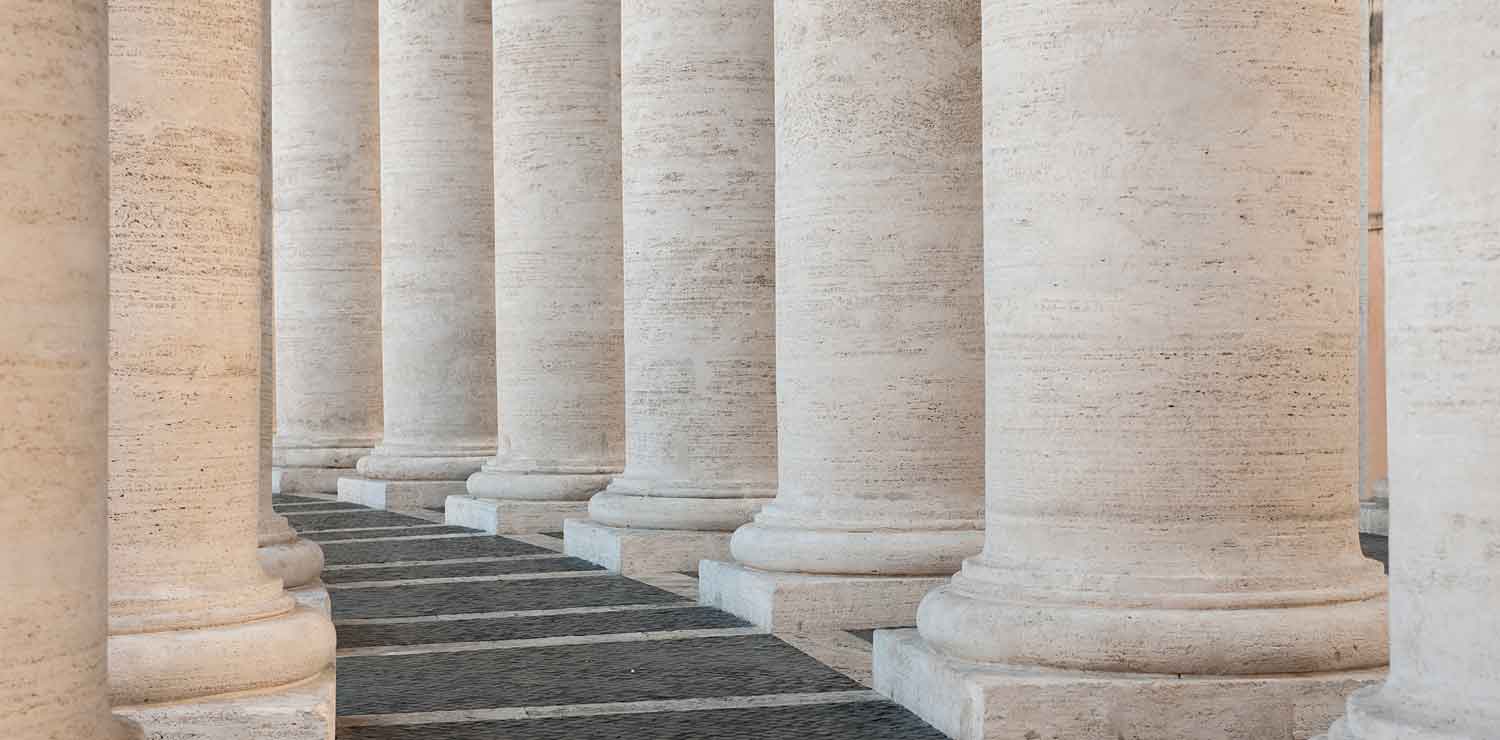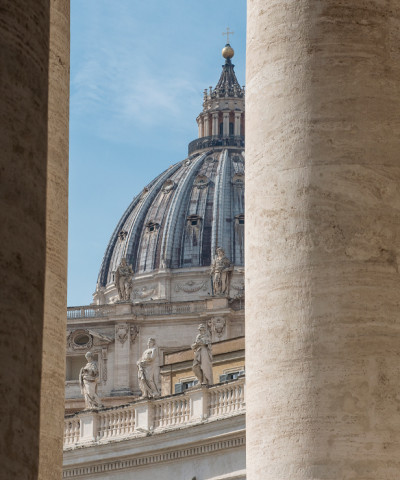Rome’s colonnades
Our journey to discover the most beautiful between past and contemporary
As simple as it is powerful. The column is a load-bearing architectural element that inevitably symbolises humans, their power and their strength. Even before the Greeks, the ancient Persians and Egyptians used them extensively. But the Romans went further: to columns and architraves they added arches to create porticoes and colonnades. Useful to provide shelter from the cold, the sun and the rain, these featured in temples, courtyards, baths, markets and ports. But more than anything, through the ages they have represented the imposing might of faith, fantasy and even political regimes. While the most ancient colonnade, in Rome’s Campo Marzio, dates back 200 years before the birth of Christ, the columns of the Forum were extremely precise in terms of proportions and placement. It was Vitruvius, the father of architecture, who defined their structure and dimensions. Colonnades connected buildings and became centres of political power. In the Middle Ages they were often used as load-bearing structures upon which to build homes, palaces and churches. Here we take a skip through Rome’s history, and suggest a few of the best.
THE PANTHEON
In front of the perfectly hemispherical dome lit by a 9-metre oculus stands the pronaos, supported by eight Corinthian columns at the front and two on either side, and topped by a Greek-style pediment. The original temple on the site was built by Marcus Vipsanius Agrippa, the son-in-law of Augustus, in 27 BC, but it was rebuilt by Hadrian between 112 and 124 AD following a fire, and dedicated to all the gods. Several centuries later it became a Christian church dedicated to the martyrs, then a mausoleum for artists and heads of state. But it is the colonnade’s size and the perfect balance between the columns of grey Elba granite and pink Egyptian stone that shows us the immensity of Roman art. Don’t miss the cascade of red rose petals on the feast of Pentecost, and the ray of sunlight that runs from the oculus to the entrance on the summer solstice.
 Pantheon
PantheonPIAZZA DI PIETRA
Named by popular tradition for the sombre and stony appearance of the temple to Hadrian that became practically a Colonna family fortress. The temple is now vanished, swallowed up by a 17th-century building by Carlo Fontana which still dominates the square. Featuring 13 white marble Corinthian columns, more than 15 metres tall - 11 of which still stand - the temple was built by the emperor Antonius Pius in 145 AD to commemorate his adoptive father Hadrian, who was worshipped as a god. Once home to the Rome Stock Exchange, since 1874 the building has been the headquarters of the Chamber of Commerce.
 Piazza di Pietra
Piazza di PietraST PETER’S
It took the genius of Bernini to scale down Maderno’s cumbersome facade and return the focus to Michelangelo’s dome. And it was the Lateran Pacts of 1929, which brought peace between church and state, that eliminated the powerful scenic effects of the alleys of Spina di Borgo, which led to the vast white open space before the basilica. 320 metres long, with 280 columns, 88 pillars and 162 statues, Piazza San Pietro opens out like an enormous hug. The church’s embrace of the faithful. In 1656 Bernini created something unique using the ancient device of the colonnade. But he widened it and made it elliptical. And, above all, he aligned every column on an axis whose fulcrum is a white stone in the centre of the square, in front of the obelisk that dominates the area of Nero’s temple. Seen from here, the four branches of the colonnade disappear, becoming a single column.
 San Pietro
San PietroSANTA MARIA DELLA PACE
Following the Pazzi Conspiracy, Pope Sixtus IV dreamed of a bleeding Madonna and made a vow: to avert a war he would build a church. The result was Santa Maria della Pace, behind Piazza Navona. The church is small but mighty. Bramante was the first to combine columns and pillars to build the cloister, and in the 17th century Pietro da Cortona turned the facade into a theatre set, with a circular pronaos and Tuscan-style columns. The Baroque period was the age of scenic effect and wonder.
 Santa Maria della Pace
Santa Maria della PaceSANTA MARIA MAGGIORE
This papal basilica dominates the Esquiline Hill with its 18th-century facade by Ferdinando Fuga. To create an appropriate space for benedictions, Fuga relied on the devices of portico and loggia, giving the church even more authority. It was built in the early Christian era, and was the scene of the miracle of snow on 5 August. In addition to Bernini’s tomb, the church also contains relics of the manger where Jesus was laid, and the world’s oldest nativity scene, not to mention the first image of the Virgin Mary.
 Santa Maria Maggiore
Santa Maria MaggioreLARGO ARGENTINA
The creation of a visitor route with suitable information was enough to make the holy area of Largo di Torre Argentina an open book. Discovered by chance in the early 20th century, it was restored after the archeologist managed to persuade Mussolini of the project. The site contains the ruins of four temples, a medieval church and the Curia of Pompey, where Julius Caesar was assassinated. The columns here, like those at the Forum, are authentic. Unmissable, to the dismay of the cats who previously had the run of the place.
 Largo Argentina
Largo ArgentinaTEMPLE OF FLORA
The little Doric temple with a four-column pronaos at the front and a curved apse at the back shows us the 18th-century fashion for recovering and modifying classical architecture. The Age of Enlightenment was all about reason, the aim being to celebrate the ancient. And the jewel-like Temple of Flora in the gardens of Villa Ada was purely for pleasure: it was a coffee-house where the wealthy sipped hot chocolate and nibbled on pastries. But the appearance of an ancient temple is convincing.
 Temple of Flora
Temple of FloraNATIONAL GALLERY OF MODERN ART
The new Kingdom of Italy also drew on classical architecture to create the first modern temple to art. The idea arose in 1883 and became a reality with the International Exhibition in 1911. The architect was Cesare Bazzani, who designed the nation’s first gallery of fine art with a monumental facade centred on massive columns combined with a late-Renaissance style cornice. Inside is the city’s largest collection of works, from Canova to Piero Manzoni.
 National Gallery of Modern Art
National Gallery of Modern ArtEUR
In the 1920s the regime dreamed up an entire neighbourhood built for the future but with deep roots in the glorious past of imperial Rome: EUR (Esposizione Universale di Roma). Wherever you turn in this area, you see impressive colonnades. They’re simpler than the ancient version but more massive, or at least designed to emulate the Rome with a million inhabitants the ruled the world. Although at the start of the war only the Palazzo degli Uffici was finished, the district was later completed, and today today is a succession of striking colonnades.
 EUR, Palazzo dei Congressi
EUR, Palazzo dei Congressi









